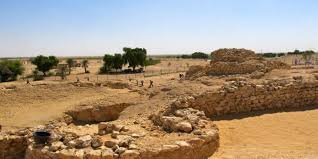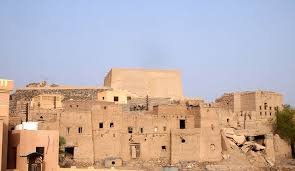Information About the The Lost City of Ubar Salalah
Hidden in the sands of Oman’s Dhofar region lies a mysterious ancient city that has captivated explorers and historians for centuries. The Lost City of Ubar, often referred to as the “Atlantis of the Sands,” is a legendary settlement near Salalah that vanished into the desert, leaving behind only whispers of its existence. This enigmatic site has been the subject of numerous expeditions and has sparked the imagination of adventurers seeking to uncover its secrets.
Recent archeological discoveries have shed new light on the Lost City of Ubar, providing valuable insights into its history and significance. Visitors to Salalah now have the chance to explore the ruins of this once-thriving desert oasis and learn about its role in the ancient frankincense trade. From the legends surrounding its disappearance to the cutting-edge technology used in its rediscovery, the story of Ubar offers a fascinating glimpse into the rich cultural heritage of the Arabian Peninsula.

The Legend of Ubar: Atlantis of the Sands
Origins of the Ubar legend
The tale of the Lost City of Ubar near Salalah has its roots in ancient Arabian folklore. This legendary settlement, often called the “Atlantis of the Sands,” has captured the imagination of explorers and scholars for generations. The story tells of a thriving city that vanished without a trace, leaving behind only whispers of its existence. Like its underwater counterpart, Ubar’s legend speaks of a prosperous civilization that met an enigmatic end.
Mentions in ancient texts
Ubar’s existence is woven into the fabric of ancient Arabian literature. The city finds mention in the famous collection of stories, “One Thousand and One Nights,” where it’s described as a flourishing center of trade and commerce. These texts paint a picture of Ubar as a wealthy and culturally rich city, playing a crucial role in the frankincense trade that once dominated the region.
Old writings, from local accounts to traders’ tales, provide glimpses into Ubar’s supposed history. They describe a city teeming with life and culture, its wealth derived from its strategic position along ancient trade routes. These mentions in historical texts have added to the allure and mystery surrounding the Lost City of Ubar.
Comparisons to Atlantis
The legend of Ubar bears striking similarities to the story of Atlantis. Both tales speak of advanced civilizations that suddenly disappeared, leaving behind only myths and speculation. This parallel has led to Ubar being dubbed the “Atlantis of the Sands,” a name that captures its enigmatic nature and the fascination it holds for many.
Just as Atlantis is said to have sunk beneath the waves, legends claim that Ubar vanished into the desert sands. Some stories suggest that the city was destroyed as a divine punishment for the wickedness of its inhabitants, echoing similar themes found in other ancient tales of lost cities.
The mystery surrounding Ubar has sparked numerous expeditions and archeological endeavors. In 1992, a team of scientists used satellite imagery to locate ruins in the Empty Quarter desert, which they believed to be the remains of Ubar. This discovery has reignited interest in the legend and has led to ongoing debates about the true nature and fate of this fabled lost city near Salalah.

The Discovery of Ubar
Satellite imagery and archeological expeditions
The quest to unearth the Lost City of Ubar near Salalah took a new turn in the 20th century. Using cutting-edge technology, explorers set out to uncover the truth behind the Atlantis of the Sands. In 1992, a team of archeologists and explorers made a groundbreaking announcement. They were virtually sure they had discovered Ubar, thanks to a combination of ancient maps and satellite imagery.
Remote sensing techniques revealed a pattern of ancient tracks and geological features that matched the descriptions of Ubar. The team used every type of remote sensing data available, including Shuttle Imaging Radar, Landsat, and SPOT satellites. These enhanced satellite images allowed them to rediscover ancient trade routes, which were packed down into hard surfaces by the passage of countless camels.
Nicholas Clapp’s role
Nicholas Clapp, a filmmaker and amateur archeologist from California, played a crucial part in the search for Ubar. After reading about the legendary city, Clapp began his research at the University of California, Los Angeles. He found a 2nd-century AD map by Claudius Ptolemy showing a place called “Omanum Emporium.”
Clapp’s breakthrough came when he approached NASA’s Jet Propulsion Laboratory with his “crazy idea” to use space imaging to locate Ubar. He convinced JPL scientists Charles Elachi and Ronald Blom to scan the region with a special radar system. This technology could “see” through the sand and soil to pick out subsurface geological features.
Excavation process and findings
Armed with satellite data, Clapp’s team, including archeologist Dr. Juris Zarins, began preliminary excavations at several sites. They quickly found that an oasis called Shisr held great promise. As they started digging, they knew they were onto something significant.
The team unearthed a complex labyrinth of structures beneath layers of sand. They discovered the ruins of a fortress ringed by eight walls, each about two feet thick and 10 to 12 feet high. At each corner stood a tower, roughly 30 feet tall. These towers were a key feature of Ubar, as described in ancient texts.
Exploring the Ruins of Ubar
Layout and architecture of the city
The Lost City of Ubar near Salalah, often called the Atlantis of the Sands, has a fascinating layout that offers insights into ancient urban planning. Archeological excavations have uncovered a complex network of structures, revealing a city with a central fortress, residential areas, and interconnected streets. What makes Ubar unique is its location atop a limestone cavern system, which played a crucial role in its eventual downfall.
The fortress and its walls
At the heart of Ubar stands an impressive fortress, a testament to the city’s former glory. This structure is encircled by eight walls, each about two feet thick, 10 to 12 feet high, and roughly 60 feet long. At each corner of the fortress, towers approximately 30 feet tall once stood, serving as the city’s primary distinguishing feature. These towers, described in ancient texts, provide strong evidence that this site is indeed the legendary Ubar mentioned in the Koran as “the many-towered city.”
The fortress likely served multiple purposes. It was home to the king, a processing and storage facility for frankincense, and a record-keeping center. In times of trouble, it provided a safe haven for the city’s inhabitants, with walls and towers that were never breached.
The sinkhole and its significance
Perhaps the most intriguing aspect of the Lost City of Ubar is the massive sinkhole that confirms its cataclysmic end. This geological feature aligns with the legend that the city vanished into the desert sands. The sinkhole formed when the limestone cavern system beneath the city collapsed, likely due to the overuse of underground water sources.
Today, visitors to the site can see sections of the fortress standing at the edge of the sinkhole, while other parts have sunk lower but remain visible. A tunnel has been constructed at the deepest end of the sinkhole, leading to underground areas where sunken walls can be observed. This unique feature not only adds to the site’s mystique but also provides valuable insights into the city’s final days.
The Lost City of Ubar near Salalah stands as a testament to the rich history and enduring mysteries of the Arabian Peninsula. Its discovery has shed light on ancient trade routes and the frankincense industry that once flourished in the region. The ruins, with their impressive fortress and intriguing sinkhole, offer a unique glimpse into a civilization that vanished beneath the sands, captivating the imagination of explorers and historians alike.
The story of Ubar serves as a reminder of the fragility of human achievements and the power of nature. It highlights the importance of preserving our cultural heritage and the value of using cutting-edge technology to uncover the secrets of the past. To dive deeper into this fascinating slice of history, why not discover The Lost City of Ubar through our packages? The ongoing research and excavations at the site promise to reveal more about this enigmatic “Atlantis of the Sands,” ensuring that Ubar will continue to intrigue and inspire future generations.
















